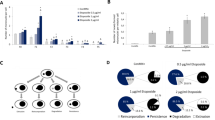Abstract
Generation of Chinese Hamster Ovary (CHO) cell lines stably expressing green fluorescent protein (GFP) was achieved using a plasmid vector that encoded the red-shifted pCX-xGFP under the control of a strong hybrid promoter composed of a CMV enhancer and a β-actin/β-globin gene promoter. Cotransfection of the promoter-less pSV2-Neo helper plasmid transmitting neomycin resistance was followed by selection with the antibiotic G418. Constitutive GFP expression could be visualized in living and fixed cells using fluorescence spectroscopy, fluorescence microscopy, and flow cytometry. DNA repair-proficient (AA8) and deficient (UV5) CHO strains were used for survival tests after UVC irradiation. Cells carrying the GFP construct (AA8-pGFP, UV5-pGFP) show the same response to UV irradiation (colony forming ability) as their nontransformed parental cell lines (AA8, UV5). Using GFP as a marker for cell viability, cells were harvested after certain postirradiation growth periods and the numbers of GFP expressing cells and fluorescence intensities were determined by FACS analysis. Generally, GFP fluorescence in irradiated cells is not seen when cell membranes are damaged (leak-out of the soluble GFP). Irradiated cells without membrane damage express GFP continuously (leading to a dose-dependent increase in GFP contents).
Similar content being viewed by others
REFERENCES
Y. Akagi, Y. Isaka, A. Akagi, M. Ikawa, M. Takenaka, T. Moriyama. A. Yamauchi, M. Horio, N. Ueda, M. Okabe, and E. Imai (1997) Kidney Int. 51, 1265–1269.
Z. Assefa, M. Garmyn, R. Bouillon, W. Merlevede, R. J. Vandenheede, and P. Agostinis (1997) J. Invest. Dermatol. 108, 886–891.
M. Chalfie, Y. Tu, G. Euskirchen, W. W. Ward, and D. C. Prasher (1994) Science 263, 802–805.
X. Cheng and G. Iliakis (1995) Int. J. Radiat. Biol. 67, 261–267.
D. Filatov, S. Bjorklund, E. Johansson, and L. Thelander (1996) J. Biol. Chem. 271, 23698–23704.
C. S. Lin, D. A. Goldthwait, and D. Samols (1990) Proc. Natl. Acad. Sci. USA 87, 36–40.
J. D. Luethy and N. J. Holbrook (1992) Cancer Res. 52, 5–10.
S. Narayan, F. He, and S. H. Wilson (1996) J. Biol. Chem. 271, 18508–18513.
Z. A. Ronai, E. Okin, and I. B. Weinstein (1988) Oncogene 2, 201–204.
L. H. Thompson, K. W. Brookman, and C. L. Mooney (1984) Somat. Cell Mol. Genet. 10, 183–194, 1984
S. Tornaletti and G. P. Pfeifer (1995) J. Mol. Biol. 249, 714–728.
F. Trautinger, I. Kindas-Mugge, R. M. Knobler, and H. Honigsmann (1996) J. Photochem. Photobiol. B 35, 141–148.
Author information
Authors and Affiliations
Rights and permissions
About this article
Cite this article
Baumstark-Khan, C., Palm, M., Wehner, J. et al. Green Fluorescent Protein (GFP) as a Marker for Cell Viability After UV Irradiation. Journal of Fluorescence 9, 37–43 (1999). https://doi.org/10.1023/A:1020583623407
Issue Date:
DOI: https://doi.org/10.1023/A:1020583623407




